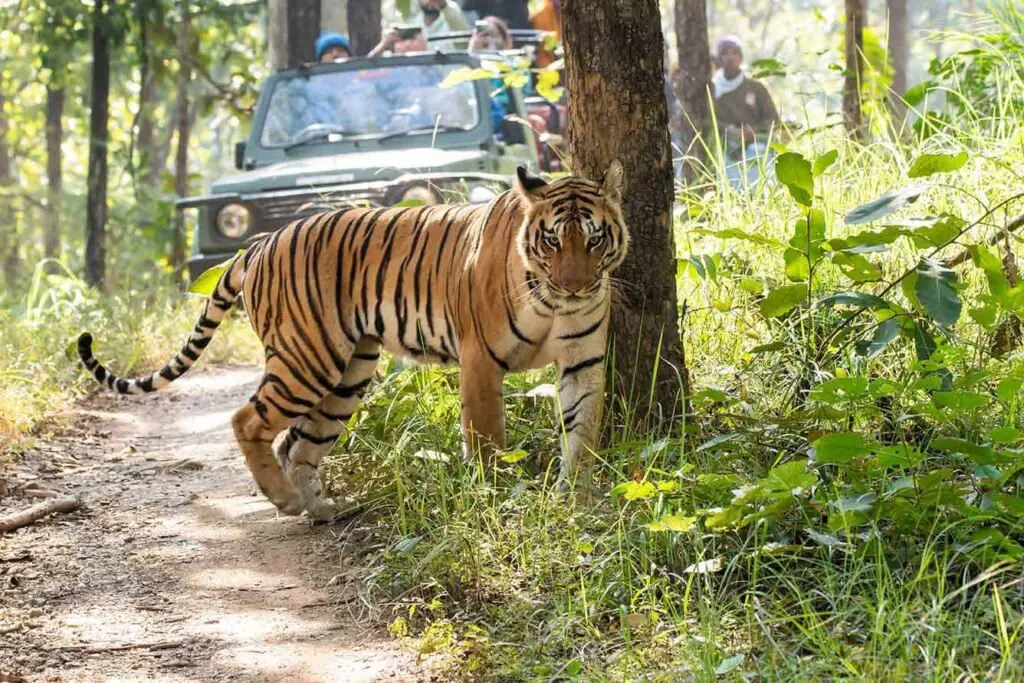ABOUT DUDHWA NATIONAL PARK
Dudhwa National Park, known as Dudhwa Tiger Reserve or Dudhwa Rashtriya Udyan, is one of India’s most captivating wildlife reserves. Located in Uttar Pradesh’s Terai region, near the Indo-Nepal border, it spans over 490 square kilometers. Established in 1977, Dudhwa quickly became part of India’s renowned Project Tiger, gaining recognition for its dedication to tiger conservation. Today, it is a haven for diverse wildlife, beautiful landscapes, and rich biodiversity, making it a top destination for nature lovers and wildlife enthusiasts alike.
KEY FEATURES OF DUDHWA NATIONAL PARK
Dudhwa National Park is distinguished by its dense forests, wetlands, and grasslands, providing unique habitats for a variety of species. Here’s a quick overview:
| Feature | Details |
|---|---|
| Location | Lakhimpur Kheri district, Uttar Pradesh |
| Year Established | 1977 |
| Area | 490 square kilometers |
| Key Attractions | Tigers, Swamp Deer, Rhinos |
| Safari Zones | Dudhwa, Sathiyana, Kishanpur, Katarniaghat |
| Best Time to Visit | November to April |
| Altitude | Ranges between 150 to 183 meters above sea level |
CLIMATE OF DUDHWA NATIONAL PARK
The climate of Dudhwa National Park is characterized by distinct seasons. Summers are typically warm, while winters are cool and pleasant. The best time to visit is from November to April, with mild weather conditions ideal for safaris and wildlife spotting. The park remains closed from mid-June to mid-November due to the monsoon, as heavy rains can make roads difficult to navigate and are essential for forest regeneration.
WILDLIFE IN DUDHWA TIGER RESERVE
Dudhwa National Park is home to an incredible variety of species, making it a must-visit for wildlife enthusiasts. Known for its population of Bengal tigers, Dudhwa is also one of the few places where you can spot the rare barasingha, or swamp deer, and the Indian rhinoceros.
Notable Species Found in Dudhwa
| Animal | Description |
|---|---|
| Bengal Tiger | The park is famous for its tiger population. |
| Swamp Deer | Also known as barasingha, a rare deer species |
| Indian Rhinoceros | Reintroduced to Dudhwa, found in specific zones |
| Leopard | Often sighted in dense forest areas |
| Asian Elephant | Frequently seen in forest and grassland zones |
| Ganges River Dolphin | Found in the Katarniaghat Sanctuary |
The park also has rich birdlife, including species like the Bengal florican, fishing eagles, and painted storks. Birdwatching enthusiasts can enjoy sightings of migratory birds during winter.
VEGETATION AND TREES IN DUDHWA RASHTRIYA UDYAN
Dudhwa’s dense forests primarily consist of Sal trees, forming a thick canopy in many areas. The park’s vegetation is a mix of tall grasslands, marshy areas, and deciduous trees, supporting various animals and providing critical habitats for different species.
| Plant Species | Description |
|---|---|
| Sal Trees | Forms dense forests; prevalent throughout Dudhwa. |
| Teak and Jamun | Commonly found, adding diversity to the flora |
| Bamboo Clusters | Provide cover and food for many animals |
| Water Lilies | Found in marshy areas, enhancing the park’s wetlands |
| Wild Grasses | Essential for herbivores like swamp deer |
TIPS FOR VISITORS TO DUDHWA NATIONAL PARK
- Best Time to Visit: Plan your trip from November to April when the climate is ideal, and most animals are active.
- Clothing: Wear neutral colors to blend with the surroundings, as bright colors can disturb the animals.
- Stay Hydrated: The weather can be warm, so bring plenty of water.
- Guided Safaris: For a safe and insightful experience, book a safari with a certified guide. Safari zones include Dudhwa, Sathiyana, Kishanpur, and Katarniaghat.
- Respect Nature: Avoid littering, follow park rules, and avoid loud noises to ensure a peaceful environment for the animals.
SAFARI EXPERIENCE IN DUDHWA
Dudhwa National Park offers organized jeep safaris across its zones, allowing visitors to experience the stunning landscape and wildlife. Morning and afternoon safaris are available, each lasting around 3 hours. Entry permits and safaris are managed by park officials, and bookings are essential during peak season. Visitors also have the unique option of an elephant safari within the rhino conservation area, offering a closer view of this protected species.
| Safari Type | Details |
|---|---|
| Jeep Safari | Available in all zones |
| Elephant Safari | Conducted in rhino conservation area |
| Safari Timings | Morning: 6:00–9:00 AM, Afternoon: 3:30–6:30 PM |
| Maximum Group Size | 6 people per jeep |
CONSERVATION EFFORTS IN DUDHWA TIGER RESERVE
Dudhwa Tiger Reserve is deeply committed to wildlife conservation. As part of Project Tiger, Dudhwa plays a vital role in protecting the Bengal tiger. Conservation efforts also focus on the barasingha and the Indian rhinoceros, ensuring these species have safe and sustainable habitats. Programs are in place to educate local communities about the importance of preserving biodiversity, helping to maintain the balance between people and wildlife.
WHY VISIT DUDHWA RASHTRIYA UDYAN?
Dudhwa National Park offers a unique and immersive experience in the heart of nature. Whether you’re drawn by the chance to see tigers, eager to observe rare birds, or interested in learning about conservation, Dudhwa has something for everyone. Its vast landscapes, diverse flora and fauna, and serene environment provide a peaceful escape, allowing you to experience India’s incredible biodiversity.
In conclusion, Dudhwa Rashtriya Udyan is a sanctuary for wildlife and a retreat for anyone looking to connect with nature. This remarkable park, with its tigers, rhinos, and rich landscapes, awaits to offer you an unforgettable adventure.


